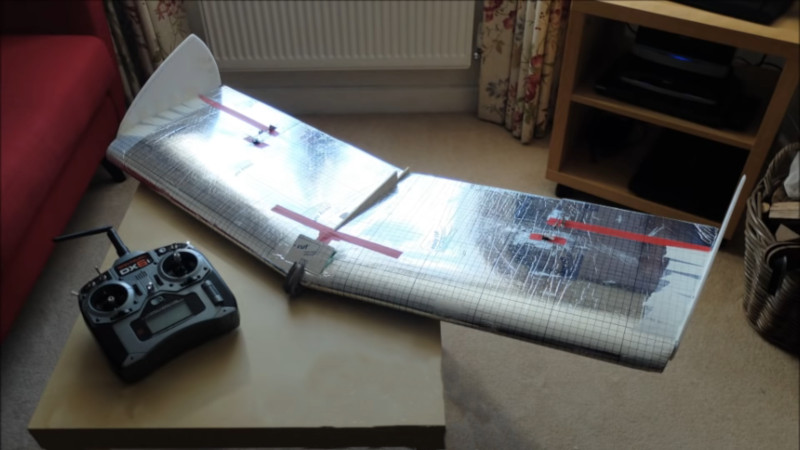Many radio control aircraft modelers will be familiar with the process of cutting wings out of foam with the hot wire method. The tools are simple enough to build at home, and it’s an easy way of producing a lightweight set of wings without too much hassle. [IkyAlvin] walks a different path, however (YouTube link, embedded below).
Expanding foam is the key here – that wonderful sticky material in a can that never quite goes where you want it to. MDF and foam is used to create a mold to produce the wing forms. It’s then a simple matter of loading floor underlay into the mold to act as the outer skin, and then filling the mold with expanding foam and waiting for it to cure.
The final parts are assembled into a flying wing, and the first test flight is remarkably successful. Using foam overlay as a skin also has the added benefit of providing a sleek silver finish to the aircraft. It goes to show that there’s always room to explore alternative techniques outside of the mainstream. If you’d like to get more familiar with the classic hot wire technique, though, we can help there too. Video after the break.















another advantage of this over hot-wire cut wings is that the mold is reusable, so when you damage the wings you can readily make replacements.
why use the foam board as a skin rather than just aluminum foil or some other release layer?
Umm, if you’re doing the hot wire method right, you’ve made light ply templates and a jig for cutting and you can bang out identical wings all day.
The skin is actually the genius of this hack.
I’ve tried to use expanding foam to mold with before, and we tried cling film, but the surface ended up pretty rugged. We tried release agents, but they turned the foam into a super-sticky, never-hardening goo. (AVOID!)
The idea of using something quasi-strong so that it holds its smooth shape on the inside of the mold, becoming the skin of the finished part, is great, and perfect for the wing application. Kudos!
Seeing this done makes me want to revisit expanding foam as a material. It’s got a great strength/weight ratio, and it’s super at (duh!) filling up space. It might make a very lightweight, hollow, 3D print more resilient.
What about cardboard as the outside? You could probably soak / melt it off. You could certainly carve both with a knife or saw. Hmmm…. Off to the hardware store.
One “release agent” and foam combination that you might try is vaseline with Loctite Tite Foam. I used some on some PLA molds and they released without problems.
Hey, this reminds me, be VERY careful in how you handle any expandable foam. A friend of mine(who can’t see very well at all…legally blind) was having to deal with some through her latex gloves and it ended up passing through the gloves somehow and dissolving them and somehow that combo got into her skin. Yes, INTO her skin. Every year or so her body pushes some of it to the surface and makes her look like she’s a victim of a horrible fire all over her hands and face and she literally has to pick it out of her own skin. The dermatologist who saw her said it wasn’t common but he had seen something like it before. He said if she’s lucky her body will have finally pushed all of it out in a few years.
I like to see new uses for old materials and this qualifies. But, is it fragile? The foam looks like it would crumble pretty easily if it takes a hit. I build with 9mm epp foam sheets folded over fishing pole spars and then laminated with copy shop laminate film. Very smooth and virtually indestructable and a real airfoil to boot (not a flatplate design).
Sorry, did not mean to imply this is a flatplate as it isn’t. I just have a fondness for real airfoils, which this one is and feel that flatplates are just not genuine nor pretty though they fly just fine.
Imagine a 2 litre pop/soda bottle with the lid off, it deforms if you twist it, or push on it. However add pressure and cap it, and it’s rigid. That’s similar to difference that this kind of foam filling will make.
i like seeing foam as part of the mold, to prevent the final product from bulging out anywhere. i also am jealous of the good strong wind at the end of the video!